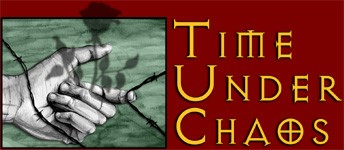
Karin Sword-DancingIndex | Time Under Chaos | Concerning Chaos | Chaosian Recreation | Karin Sword-Dancing "This is the Karin Sword Dance. The winner of the original game played in the shadow of Karin became king after he killed his opponent. The Hendrake version is not quite so deadly." - Helena, daughter of Fiona and Mandor The BackgroundThe Karin sword dance is part art-form, part martial training, part competition. Originating in the shadow of Karin, the Sword Dance was originally used to decide many an issue, including the time of the passing of rein. The heir, when he was deemed ready, would fight the king in mortal combat, using the sword dance as the framework in which to compete. If the challenger won, he was given not only the throne, but the right of life and death over his former liege. If the king won, the challenger was automatically sacrificed. In Chaos, it is not used to decide such weighty matters- at least, not ostensibly. The Playing FieldThe Karin sword dance is played on a field of squares, even on both sides. The basic game is played on an 11x11 grid, but other variants use more or less real estate, resulting in a longer- or shorter- game, though the number of squares on a side is always an odd number. The field starts off coloured in on shade, but each player is given his or her own colour, and as they capture space, the grid squares change to their colour to show that they own the territory. The GoalThe Karin sword dance is won by meeting one of four objectives. The first victory condition is to amass the most points by the time that all of the squares are coloured, or no further moves can be made by one or both players. The second way to win is to defeat your opponent in a sparring match when you are the agressor. The third way to win is to force your opponent completely from the field of battle. The final way to win is to make your opponent unable to continue. The RulesOnce it is determined who shall take the first move, the player executes one of the 97 martial steps of the Kraít Taz? martial art- the root of all martial arts according to Hendrake historians. The judge rates the performance as either acceptable, or not. If the form is accepted, the player can move a number of spaces as dictated by the difficulty of the form he utilized, and captures each square he takes. The player cannot move over already captured space- even his own. As the basic game is a test of martial prowess, and not shapeshifting, sorcery skills, or Chaos mastery, these are prohibited from use during the contest. Some variants allow their use, and add other, more radical changes to the base rules. The MovesMovement towards the opponent's edge of the board, or to either side, is referred to as Leyward movement. It is easiest to make Leyward movement; it is always possible, no matter what form is chosen. Movement away from the opponent is referred to as Byssward movement. More difficult forms are required- only tier two forms allow Byssward movement. Diagonal movement is referred to as movement Askew. Only tier three forms allow movement Askew. Within each tier, each form is given a rating from one to three. This rating is the number of squares that a successful performance of this form allows the practitioner to capture. The EndgameOnce more than one-half of the available spaces have been captured, challenges can begin, only if the captured territory touches in locations. Only the person that holds the most territory can initiate a challenge. The challenged party choses the weapons for the match- in general, only sanctioned weapons? can be chosen. Weapons are sanctioned based upon the form of the match- whether it is friendly or not. Sanctioned weapons during a friendly match include the dray?, the quarterstaff, the shortstaff, the mang?, the tjabang?, the yung?, and the kipas?. Otherwise, whatever weapons are agreed upon at the beginning of the match are acceptable. In general, challenges are 3 minutes long, and can be won by forcing the opponent to surrender, or forcing the opponent to touch a square that is not his own colour. If the challenger wins, then the game is concluded in his favour. If the challenged party wins, half of the challenger's territory is returned to a neutral state. The Variants |